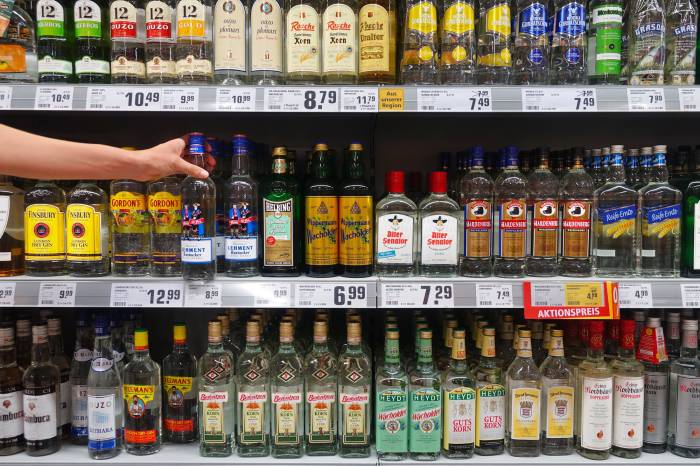Ready-to-Drink Spirits Surge 28.4% as U.S. Market Faces 4% Decline in Distilled Spirits Value
Cutwater leads explosive RTD growth while inflation, health trends, and shifting consumer habits challenge traditional premium brands
2025-10-24

Recent data from Mark Brown’s Industry News Update shows that the U.S. spirits market is experiencing significant changes, with ready-to-drink (RTD) beverages gaining ground and traditional premiumization trends facing new challenges. For the four weeks ending October 4, RTDs increased their market share by 420 basis points compared to the same period last year. This growth has put pressure on overall pricing and product mix, making it harder to see where consumers are still willing to pay more for higher-end distilled spirits.
AB InBev’s Cutwater brand led the surge in RTDs, outpacing growth not only within its category but across the entire spirits sector. The popularity of RTDs highlights a shift in consumer preferences toward convenience and innovation. According to Mark Brown’s newsletter, the U.S. beverage alcohol industry is currently undergoing a correction, a trend that has been explored in depth in the publication’s Future of Alcohol series.
Despite the rise of RTDs, the overall performance of distilled spirits remains under pressure. Nielsen data indicates that the value of distilled spirits is down about 4% year over year, falling short of historical growth rates. The Distilled Spirits Council of the United States (DISCUS) reports that, excluding RTDs and pre-mixed cocktails, the 2024 run rate was slightly better at -3.0% in volume and -2.6% in value. Within this environment, consumers are trading down in categories like vodka and rum, while whisky, gin, and tequila continue to show some signs of premiumization. However, tequila’s growth has shifted away from high-end prestige labels toward more affordable premium brands.
Mark Brown’s team has identified 27 headwinds facing the beverage alcohol sector, grouped into four main themes: macroeconomic pressure, health and moderation trends, cultural shifts, and marketing challenges. Prolonged inflation has led consumers to cut back on discretionary spending, including alcohol. At the same time, changing attitudes toward health, stricter regulations, and the popularity of weight-loss drugs have softened demand. The evolving role of alcohol in social settings and competition from cannabis are also affecting the industry’s ability to attract new consumers. Finally, many companies are struggling to adapt their marketing strategies to these new realities.
Price and mix trends across categories show a mixed picture for October compared to the previous month. Tequila prices fell by 1.5%, gin rose by 1.9%, vodka remained flat, rum dropped by 0.7%, bourbon edged up by 0.2%, Canadian whisky declined by 0.9%, cognac fell by 1.2%, and Scotch increased by 1.8%. These numbers suggest that while some categories—especially whisky and gin—are still attracting consumers looking for value-driven premium options, others are seeing weaker pricing.
Tequila sales dropped 4% in October, with volume down 2.5%. Major brands like Don Julio, Casamigos, and Patrón saw some of the steepest declines in the category. In contrast, Scotch and Irish whiskey maintained their premium positioning despite falling volumes. Scotch volumes were down 11%, but price/mix improved by 1.8%, driven by single malts like Lagavulin. Irish whiskey held steady, with Jameson showing a slight volume decline over a 12-week period.
American whiskey continues to see premiumization, led by high-end brands such as Colonel Taylor, while mass-market labels like Jack Daniel’s and Jim Beam experienced declines. Canadian whisky presented a different story: Crown Royal saw an 8.7% drop in October after previously posting growth, possibly due to fluctuations related to new product launches.
In white spirits, vodka prices and mix were flat, with growth supported by Tito’s and lower-priced competitors. RTDs remained the fastest-growing segment, up 28.4% year over year, with Cutwater leading at an impressive 86.8% growth rate. Other brands like Surfside, Sun Cruiser, and BuzzBallz also performed well.
Major global spirits producers remain heavily exposed to U.S. market trends, with Diageo deriving about half its revenue from the U.S., Rémy Cointreau about 40%, Campari around 25%, and Pernod Ricard a similar share.
The U.S. spirits market is clearly in transition as RTDs reshape drinking occasions and inflation affects consumer spending habits. Brands are now challenged to balance accessibility with aspiration as premiumization evolves from exclusive luxury labels to more attainable options for a broader audience. Flexibility and innovation will be key for companies hoping to lead in this changing landscape.
The information for this report comes from Mark Brown’s Industry News Update—US Spirits, De-premiumisation Tracker October 2025.
Founded in 2007, Vinetur® is a registered trademark of VGSC S.L. with a long history in the wine industry.
VGSC, S.L. with VAT number B70255591 is a spanish company legally registered in the Commercial Register of the city of Santiago de Compostela, with registration number: Bulletin 181, Reference 356049 in Volume 13, Page 107, Section 6, Sheet 45028, Entry 2.
Email: [email protected]
Headquarters and offices located in Vilagarcia de Arousa, Spain.